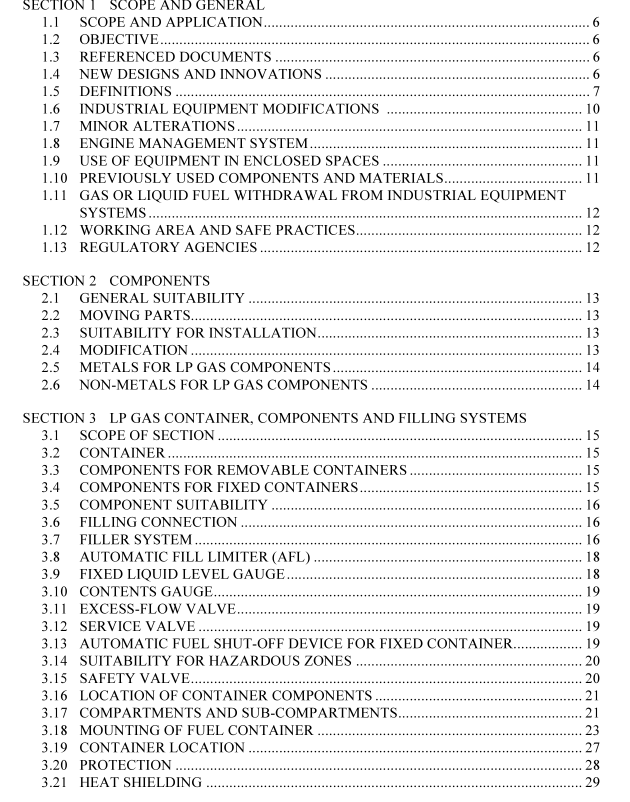AS 4983 pdf download – Gas fuel systems for forklifts and industrial engines

AS 4983 pdf download – Gas fuel systems for forklifts and industrial engines
1.5.3 Authority(ies)
The authority(ies) having regulatory powers to control the design,manufacture andinstallation of equipment described in this Standard in the country,State or Territory inwhich the equipment is registered.
NOTES:
l In some areas,industrial equipment installations and stationary installations are under thecontrol of different authorities.
2A listing of agency information is provided in Appendix B.1.5.4 Automatic fill limiter (LP Gas)
A provision in the filling system that automatically terminates filling when a predeterminedliquid level in the container has been reached.
1.5.5 Automatic fuel shut-off device
A provision for automatically shutting off the fuel supply unless certain essential conditionsare met.
1.5.6 Capacity (of a container)
The total internal volume of the container, expressed in litres.NOTE: This is also known as “water capacity’ .
1.5.7Closed-loop system
An engine management system whereby details of the oxygen content in the exhaust gasesis fed back into the management system to control the air/fuel mixture.
1.5.8 Compartment
A structure that encloses the whole of the container and its fittings,whose purpose is tocollect any gas leakage that might occur, so that it can be discharged to open air.
NOTE: The primary function of a compartment or sub-compartment is leakage collection anddischarge,not physical protection. This is a separate need, which may equally well be providedby some other means.
1.5.9 CNG (Compressed natural gas)
A compressed gaseous fuel composed of natural gas of pipeline quality,as defined inAS 4564.
1.5.10 Container
A pressure vessel, cylinder or tank for the storage of LP Gas or CNG to be used as fuel foran engine.
1.5.11 Container manufacturer certificate
A manufacturer’s certificate containing information including the container designinformation/drawing, the container Standard designation, the container model number,therated working pressure,serial numbers, an Australian container design registration number,the expiry date (if applicable) and inspection interval.
1.5.12 Contents gauge
For LP Gas, a gauge that gives a visual indication of the liquid content of the container.
For CNG, a gauge that gives a visual indication of the container pressure.
This may be read at the container or remotely.
1.5.13 Decanting
A procedure in which the liquid phase of LP Gas is transferred from one container toanother by utilizing the difference in pressure between the two containers.
1.5.14 Double non-return valve
Two non-return valves arranged in series to provide dual security against backflow.1.5.15 Excess-flow valve
A valve,normally in the open position, that closes automatically when flow in a specifieddirection exceeds a predetermined limit.
1.5.16 Factory assembling
An operation carried out by the Original Equipment Manufacturer(OEM) prior to supply ofthe equipment to market.
1.5.17 Fill line
Piping used for the conveyance of fuel from the filling connection to the container.1.5.18 Fixed liquid level gauge
A gauge that indicates the maximum permitted liquid level in the LP Gas fuel containerincorporating a tube arranged with its open end located at the liquid level, so that gaseousdischarge changes to liquid discharge as the liquid surface reaches the level.
1.5.19 Fuel filter
A component that is capable of removing from the fuel all particulate matter,which couldcause malfunction of other components or valves downstream in the system, and is capableof being removed, cleaned or replaced.
1.5.20 Fuel injector
A device operated by an engine management system for injecting LP Gas into the engineunder pressure either in liquid or gaseous form.
1.5.21 Fuel service line
Piping, other than the fill line,used for the conveyance of fuel from the container to the fuelvaporiser/regulator at a pressure exceeding 450 kPa.
1.5.22 Gas-air mixer
A device for introducing gaseous fuel to the induction air of the engine.1.5.23 Hydrostatic relief valve
A valve that relieves and prevents overpressure in any fuel service line carrying LP Gasliquid.
1.5.24 Ignition source
A source of energy sufficient to ignite a flammable atmosphere and includes naked flames,exposed incandescent material,electric welding arcs, and electrical or mechanicalequipment or components not approved for use in hazardous areas.
Forklift or industrial engines are not regarded as being an ignition source while entering orleaving the hazardous zone surrounding a fuel dispenser for refuelling purposes.









